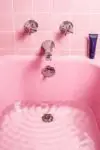
Even though utility bills usually comprise a small portion of the housing budget, they tend to add up and cumulate into significant yearly expenses. Saving water and energy is not only useful for improving your personal finance, but also an environmentally conscious move.
READ MORE: 35 Energy Efficiency Upgrades That Will Cut Your Energy Costs
An average household wastes thousands of gallons of water and kilowatt-hours of energy, draining precious natural resources. Most of the energy produced for household needs comes from the burning of fossil fuels, increasing the carbon footprint, and accelerates global warming. Global warming, in turn, is causing desertification with many water basins drying up, destroying the natural habitat of thousands of species. Fresh-water resources are depleting every year. By cutting down your energy and water usage, you are doing a favour to the environment, as well as your budget. Here are some tips on how to make your washroom energy efficient.
Unplug Appliances
Washrooms usually have a lot of appliances. These appliances can employ a lot of energy, even when they are not in use. If the device is plugged, it is still passively consuming substantial amounts of energy. To save on energy, you need to unplug the appliances. Leaving your electric shaver to charge for a whole day can cost you a few bucks a month. Alternatively, you can use a timer switch off your outlets. Set up a timer to turn off the energy during the workday, when the appliances are not in use.
Buy a Low-Flow Faucet Aerator
It seems like the sink does not use that much water in contrast to the bath, shower, or toilet. Nevertheless, it can still put a string on your budget since it can flow up to 4 gallons of water per minute. Those numbers tend to add up, especially if you habitually forget to turn off the faucet when you shave or brush your teeth. Turning off the facet during this routine is an excellent energy-saving idea.
Moreover, you can install low-flow faucet aerators. This small addition to your bathroom can cut in half your water waste and positively affect your energy bills. You can purchase an aerator for as little as $2 – a small price for substantial savings.
Change the Showerhead
Showering is one of the primary sources of water waste. Many of us are using a shower without giving it too much thought. We take long, relaxing showers or leave the water running to let it warm up. Of course, reducing your shower time would be a great energy-efficient tip, but there are other ways to save without sacrificing the pleasures. One of the smart solutions is installing low-flow showerheads. Those devices usually deliver 2.5 gallons of water per minute instead of the excessive 5 gallons per minute of the older models.
Upgrade the toilet
Toilets are one of the most water-wasteful plumbing appliances in most households. The toilet uses almost a third of the average home water consumption. In the older toilet models, an average flush utilizes around 3.6 gallons, adding up to the daily usage of 18.8 gallons per person per day. However, sustainable home technologies have come a long way and designed water-saving mechanisms for toilets. There are three main types of water-saving toilets:
- Pressure assist toilets
- Low flush toilets
- Dual flush toilets
Pressure-assist toilets make use of the air cartridge that thrust water from the tank, creating a much more powerful flush while using as little as 1 gallon per flush. The significant downturn of the pressure-assisted toilet is its loud flush. Another drawback is a relatively complex design that can potentially cause problems with the repair, the spare parts are not cheap, as well the toilet itself
Low flush toilets are designed to use significantly less water, with an average flush of 1.6 gallons, reducing the daily use to 9.21 gallons per person per day, although it is not very efficient in removing solid wastes.
Dual flush toilets are a type of smart home device. They use sensors to customize their flush for either solid or liquid waste. This device is on the higher end of the price spectrum but can bring substantial savings. Other toilet models use the combination of these three types.
If you live in a rental, double-check the local rental laws before doing the upgrades, to determine who is responsible for the cost of the enhancements; you or the landlord.
Use Efficient Bulbs

Washrooms usually use more lighting than any other room in the house. These rooms are usually deprived of windows and natural lights, for obvious privacy concerns, and yet they are supposed to be bright. To keep them this way and still save on the electricity bills, you should consider installing the energy-efficient light bulbs. Some energy-efficient bulbs are even brighter than the traditional ones, and they last longer. Although they might be more upfront expensive, they will save your energy and money in the long-run. There are three major types of energy-efficient light bulbs:
Halogen Incandescent
Halogen incandescents have an intricate inner structure. They have a capsule with an inert gas around the filament to increase the brightness and lightbulb efficiency. In contrast to other options, these bulbs can be disposed of in regular household waste, and they meet the minimum energy-efficient standards. Nevertheless, there are more energy-efficient options.
CFL
The compact Fluorescent lamp is the smaller curly version of the fluorescent light tube that can be frequently encountered in the warehouse or even offices. It uses the phenomenon of fluorescence to produce light by putting electrical current through the mercury-vapour, which produces short-wave ultraviolet light that makes the phosphor on the coating of the lamp glow. They are expensive, and yet incredibly long-lasting, ten times more than the traditional light bulb. They usually pay for themselves in less than 8 months, and then keep saving you money. CFL uses about one-third of the energy of halogen incandescents. The only downturn is that due to the small amounts of mercury, it cannot be disposed of in the regular trash, and have to be brought to a specific recycling point.
LEDs
A light-emitting diode is a semiconductor that converts electricity into light. It is commonly used in the traffic light, or as an indicator on the dashboard. Nevertheless, LED is one of the most energy-efficient and rapid-developing technology. The top-notch LEDs use only about 20% of the energy and last 20-25 times longer than traditional light bulbs. LEDs can be disposed of in the household waste.
Install Sensors
Various smart home devices can help to use your appliances much more efficiently. Installing motion sensors can significantly reduce energy bills. That is especially true if you tend to leave the washroom light on or have forgetful kids. The motion sensors would turn the light on when they detect a movement and then turn them off after a certain period of time if the new movement was not detected. You can also install a timer on the washroom ventilation, so it turns itself off after a certain period of time. Leaving ventilation on for too long misuse a substantial amount of the house heat.
Clean and fix regularly
You should dust the radiator surface every week. Greasy and dusty radiator surfaces prevent the flow of heat. Regularly check the plumbing and faucets; even a small leak can result in tremendous waste over a long period of time.
To sum up
Energy-savings can be achieved by establishing a conscious water and energy usage routine, which includes not taking long showers, brushing teeth with the turned-off faucets, remembering to turn off the light.
However, in our modern, fast-paced life, it is hard not to forget about such mundane things. Additionally, sometimes it means sacrificing your comfort and life-long habits. The aforementioned washroom upgrades can help you smash your energy bills while maintaining your familiar way of life. The washroom is not the only room that is draining your budget; there are a lot of other useful upgrades you can do to save on your energy bill.
This article is a guest post written by the folks at Rentberry.com.











